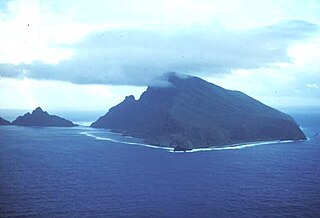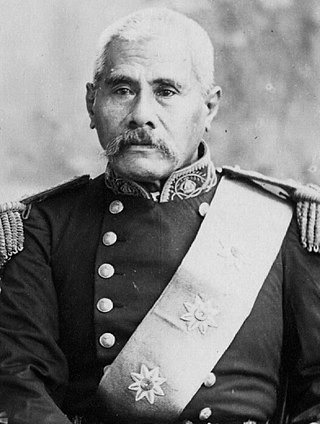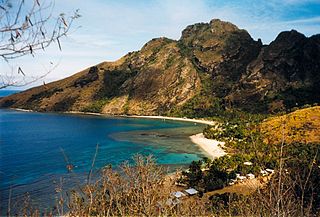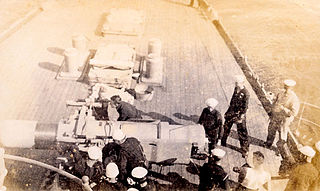
Politics of Samoa takes place in a framework of a parliamentary representative democratic state whereby the Prime Minister of Samoa is the head of government. Existing alongside the country's Western-styled political system is the faʻamatai chiefly system of socio-political governance and organisation, central to understanding Samoa's political system.

The Samoan Islands are an archipelago covering 3,030 km2 (1,170 sq mi) in the central South Pacific, forming part of Polynesia and of the wider region of Oceania. Administratively, the archipelago comprises all of the Independent State of Samoa and most of American Samoa. The land masses of the two Samoan jurisdictions are separated by 64 km of ocean at their closest points.

Savaiʻi is the largest and highest island both in Samoa and in the Samoan Islands chain. The island is also the sixth largest in Polynesia, behind the three main islands of New Zealand and the Hawaiian Islands of Hawaii and Maui. While it is larger than the second main island, Upolu, it is significantly less populated.

The Pacific Squadron of the United States Navy, established c. 1821 and disbanded in 1907, was a naval squadron stationed in the Pacific Ocean in the 19th and early 20th centuries.

The United States Exploring Expedition of 1838–1842 was an exploring and surveying expedition of the Pacific Ocean and surrounding lands conducted by the United States. The original appointed commanding officer was Commodore Thomas ap Catesby Jones. Funding for the original expedition was requested by President John Quincy Adams in 1828; however, Congress would not implement funding until eight years later. In May 1836, the oceanic exploration voyage was finally authorized by Congress and created by President Andrew Jackson.

The Second Samoan Civil War was a conflict that reached a head in 1898 when Germany, the United Kingdom, and the United States were locked in dispute over who should have control over the Samoan island chain, located in the South Pacific Ocean.

Susuga Malietoa Tanumafili I was the Malietoa in Samoa from 1898 until his death in 1939. After the death of his father, Malietoa Laupepa, who was recognized as king of Samoa by many Western countries, Tanumafili was immediately crowned, with Tupua Tamasese Lealofi I serving as vice-king. Tanumafili was backed by the United States and United Kingdom, however Germany supported rebel chief Mata‘afa Iosefo who was eyeing the throne. The battle between the two made up the Second Samoan Civil War and in the end caused the Tripartite Convention that split the islands. After the war, Malietoa pursued education in Fiji and then came back to Samoa, where he was appointed as an advisor.
Le Susuga Malietoa Talavou Tonumaipeʻa was installed as "King" of Samoa to the western world on August 28, 1879, until his death on November 9, 1880. Since Malietoa Talavou's half brother's death, Malietoa Moli in 1860, ongoing wars due to power and authority struggle between Talavou and Laupepa over the next Malietoa title holder and the gaining of support by the districts of Samoa. Family rivalry existed as did a 30-year age difference drew a wedge between Malietoa Laupepa and Malietoa Talavou. They were known to be longtime rivals over the Malietoa title.

Mālietoa is a state dynasty and one of the four paramount chiefly titles of Samoa. It is the titular head of one of the two great royal families of Samoa: Sā Malietoa. Literally translated as "great warrior", the title's origin comes from the final words of the Tongan warriors as they were fleeing on the beach to their boats, "Malie To`a, Malo e tau...".

The First Sumatran expedition, which featured the Battle of Quallah Battoo in 1832, was a punitive expedition by the United States Navy against the village of Kuala Batee, presently a subdistrict in Southwest Aceh Regency. The reprisal was in response to the massacre of the crew of the merchantman Friendship a year earlier. The frigate Potomac and its crew defeated the local uleëbalang (ruler)'s forces and bombed the settlement. The expedition was successful in stopping Sumatran attacks on U.S. shipping for six years until another vessel was plundered under different circumstances, resulting in a Second Sumatran expedition in 1838.

Malietoa Mōli [Semoanaifea] was a Samoan king who died in 1860.

The Second Sumatran expedition was a punitive expedition by the United States Navy against inhabitants of the island of Sumatra. After Malay warriors or pirates had massacred the crew of the American merchant ship Eclipse, an expedition of two American warships landed a force that defeated the Malays in two short engagements.

The Battle of Tonkin River was a major naval battle fought in northern Vietnam between the pirates of Shap Ng-tsai and the British Royal Navy with aid from the Qing Chinese navy and the Tonkinese. The 1849 expedition led to the destruction of Shap Ng-tsai's fleet and the loss of over 2,000 men. The battle occurred over a three-day period at the mouth of the Tonkin River, near present-day Hai Phong.

The Battle of Tysami was a military engagement involving a warship from the British China Squadron and the Chinese pirates of Chui A-poo. It was fought in September 1849 off Tysami, Harlaim Bay, China, and ended with a Royal Navy victory. It was also the precursor engagement to the larger Battle of Pinghoi Creek where Chui A-poo's fleet was destroyed.

The SecondBattle of Vailele was fought during the Second Samoan Civil War in 1899. British, American and Samoan forces loyal to Prince Tanu were defeated by a superior force of Samoan rebels loyal to Mata'afa Iosefo. Fighting occurred at the former German plantation of Vailele, Samoa and was a major engagement in the small colonial conflict.

The siege of Apia, or the battle of Apia, occurred during the Second Samoan Civil War in March 1899 at Apia. Samoan forces loyal to Malietoa Tanumafili I were besieged by a larger force of Samoan rebels loyal to Mata'afa Iosefo. Supporting Malietoa were landing parties from four British and American warships. Over the course of several days of fighting, the Samoan rebels were defeated.

The Second Fiji expedition was an 1859 United States Navy operation against the native warriors of Seru Epenisa Cakobau on the island of Waya in Fiji. Following the death of two American traders on Waya, the Pacific Squadron launched a punitive expedition against the Wayans and defeated them in a pitched battle at the village of Somatti.

The Ivory Coast expedition, or the Liberia expedition, was a naval operation in 1842, launched by the United States against the West African Bereby people. After the attacks on the merchant ships Mary Carver and Edward Barley, the American Congress approved a punitive expedition to the area and placed Commodore Matthew C. Perry in command. The expedition was successful in exacting redress by destroying the fortified town of Little Bereby and by killing the chief responsible for the attacks on American shipping.

The Santo Domingo Affair, or the Santo Domingo Crisis, refers to an incident from 1 February 1904 to 11 February 1904 involving the United States and Dominican militia forces in the Dominican Republic. After the death of a seaman from the USS Yankee on February 1, the U.S. military launched a punitive expedition which routed the Dominican forces.

The Battle of Drummond's Island was a conflict between the United States Exploring Expedition and the village of Utiroa in April 1841 at Drummond's Island, Tabiteuea North, which is now part of Tabiteuea. The cause of the conflict was the disappearance of the American seaman John Anderson, who was suspected, with no evidence, to have been murdered by the village natives. In retaliation, the members of the expedition killed twelve of the natives and burned the village of Utiroa to the ground.




















